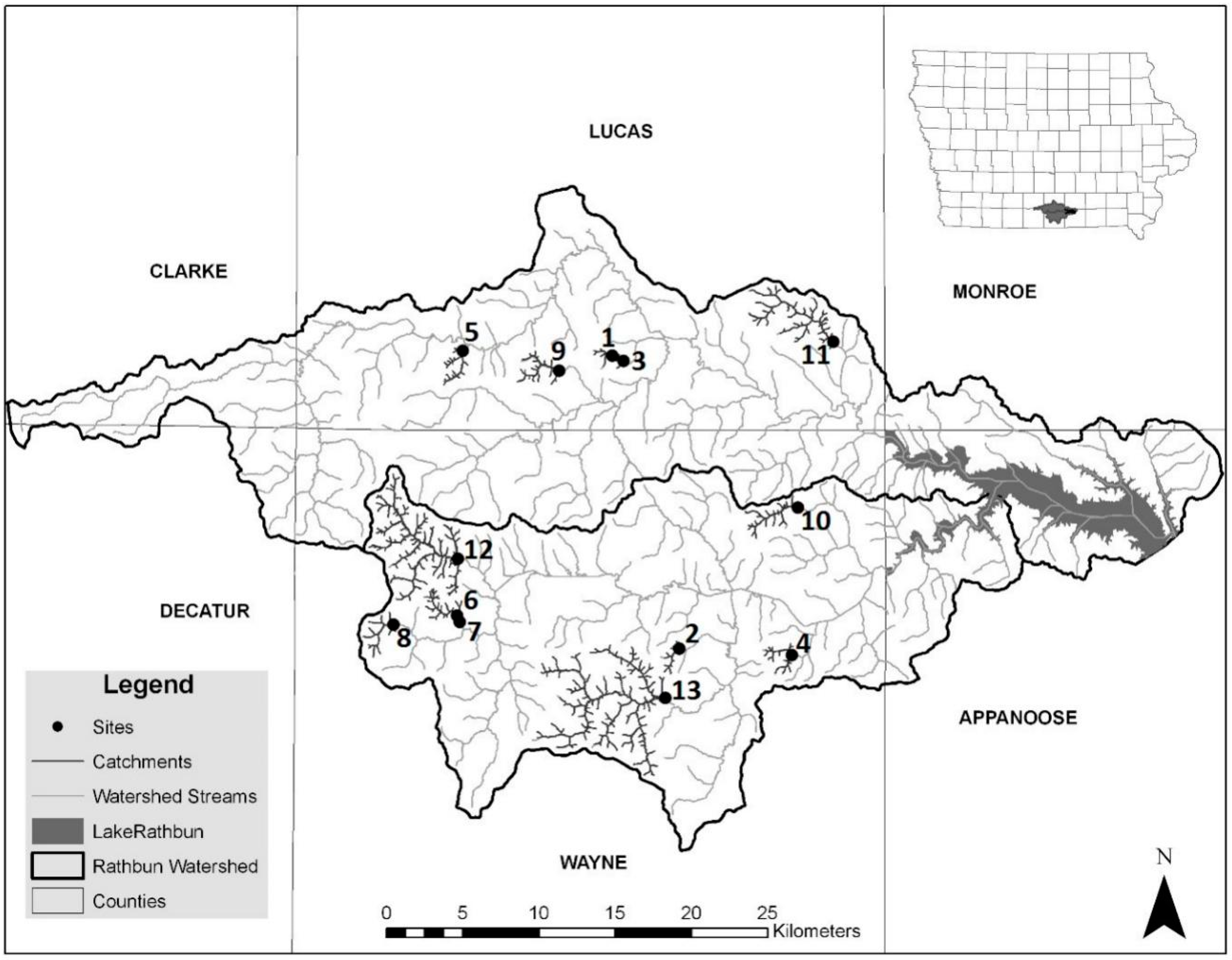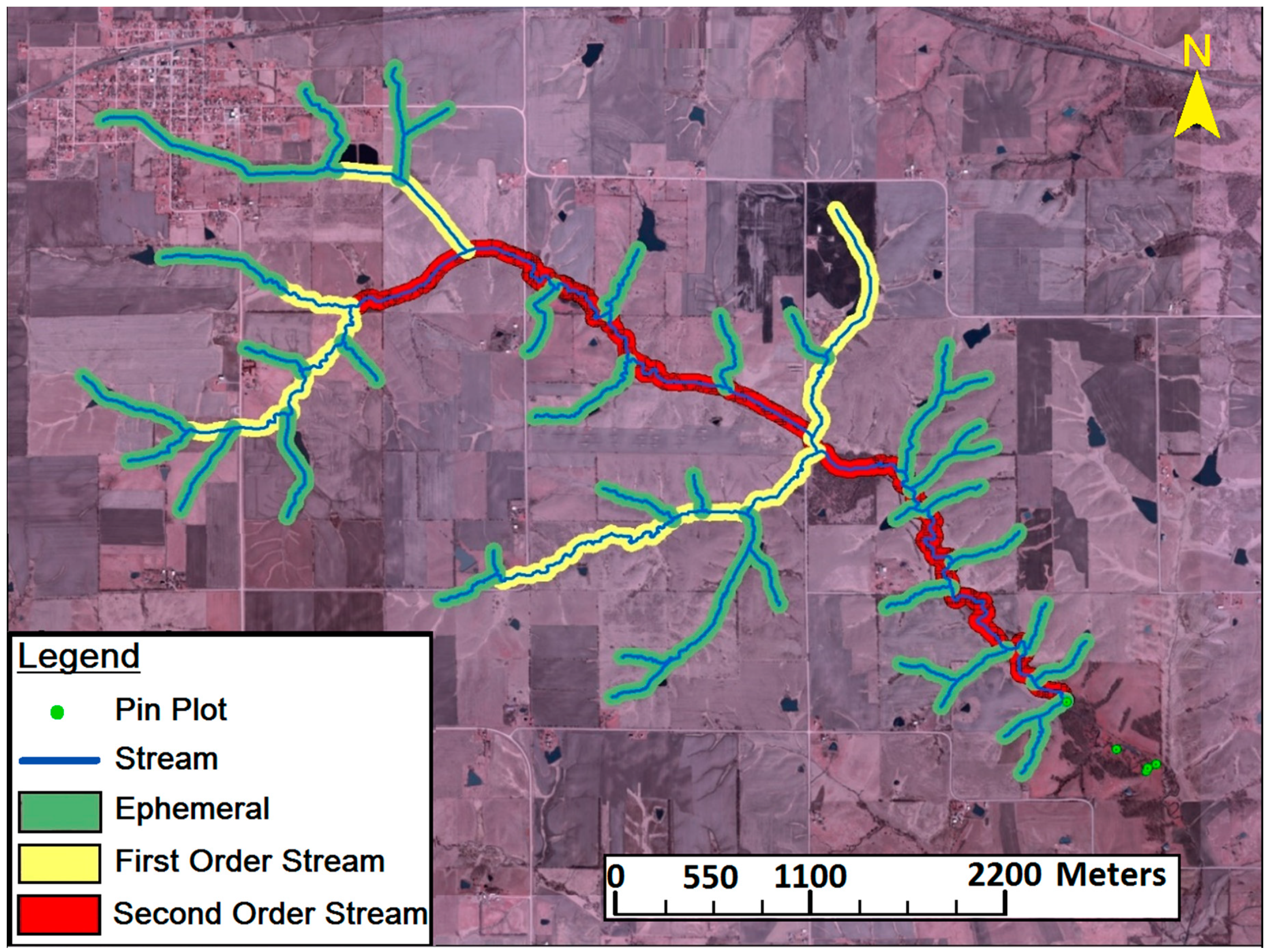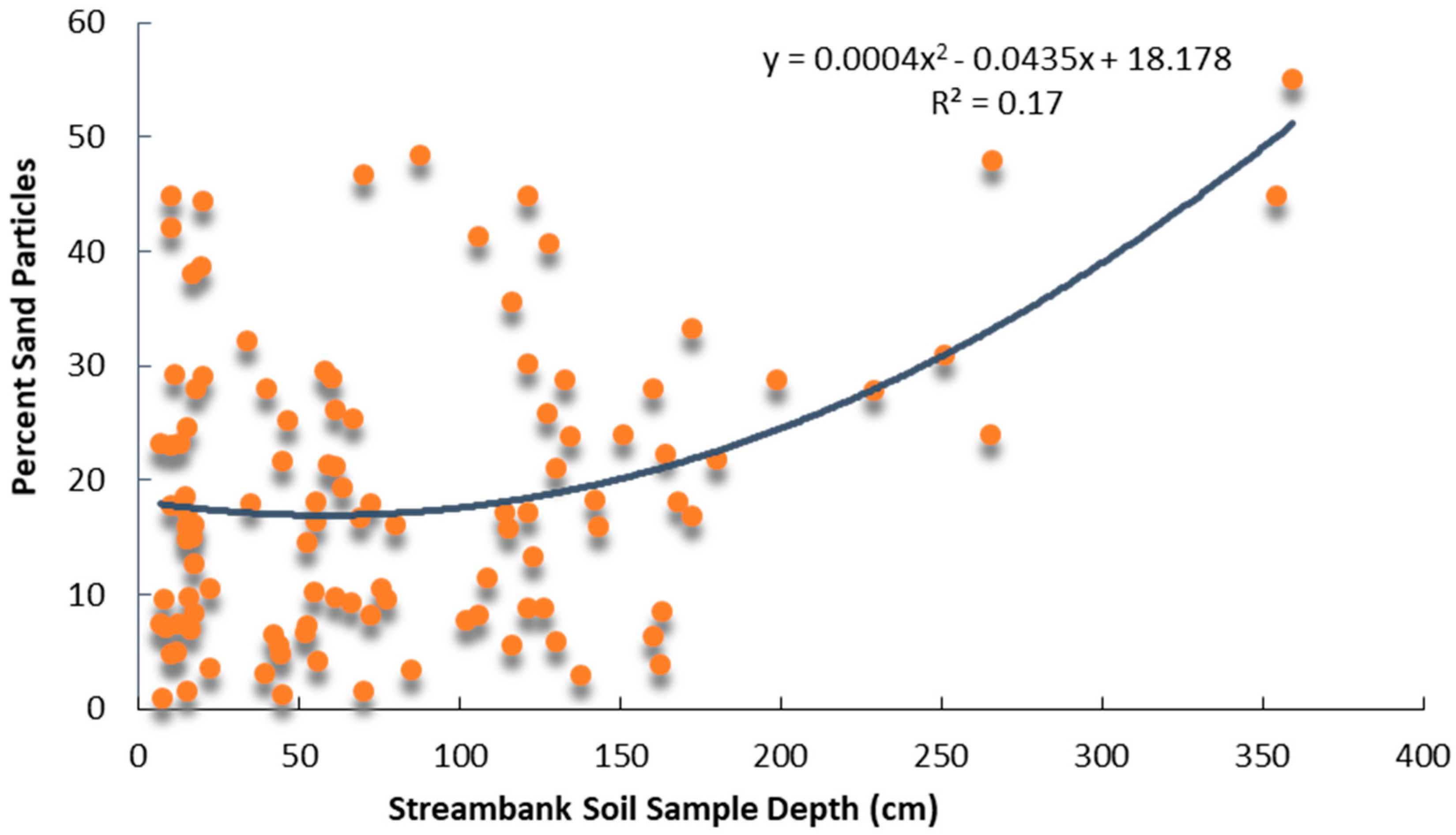Riparian Land-Use, Stream Morphology and Streambank Erosion within Grazed Pastures in Southern Iowa, USA: A Catchment-Wide Perspective
Abstract
1. Introduction
2. Materials and Methods
2.1. Study Sites and Treatments
2.2. Scope of the Work
2.3. Streambank Soil Particle Size Analysis
2.4. Stream Bed Slope and Sinuosity
2.5. Land-Use Determination within 50 m Strips on Either Side of the Stream
2.6. Catchments Size, Total Stream Lengths and Stream Order Classification
2.7. Data Analysis
3. Results and Discussion
3.1. Streambank Soil Particle Size
3.2. Stream Bed Slope and Sinuosity
3.3. Catchment Stream Length and Size
3.4. Impacts of Land Use within 50 m Strips on Either Side of the Stream
4. Summary and Conclusions
Author Contributions
Funding
Acknowledgments
Conflicts of Interest
References
- Ritter, D.F.; Kochel, R.C.; Miller, J.R. Process Geomorphology, 4th ed.; McGraw-Hill Companies, Inc.: New York, NY, USA, 2002; p. 190. [Google Scholar]
- Whitney, G.G. From Coastal Wilderness to Fruited Plain: A History of Environmental Change in Temperate North AMERICA, 1500 to Present; Cambridge University Press: Cambridge, UK, 1994. [Google Scholar]
- Guthrie, W.K. Drainage, drainage, drainage: Creating natural disasters in Southeastern Nebraska. Great Plains Q. 2000, 20, 297–310. [Google Scholar]
- Knox, J.C. Agricultural influences on landscape sensitivity in the Upper Mississippi River Valley. Catena 2002, 42, 193–224. [Google Scholar] [CrossRef]
- Lane, E.W. Design of stable channels. Trans. Am. Soc. Civ. Eng. 1955, 120, 1234–1260. [Google Scholar]
- Simon, A.; Klimetz, L. Relative magnitudes and sources of sediment in benchmark watersheds of the Conservation Effects Assessment Project. J. Soil Water Conserv. 2008, 63, 504–522. [Google Scholar] [CrossRef]
- Simon, A.; Rinaldi, M. Disturbance, stream incision, and channel evolution: The roles of excess transport capacity and boundary materials in controlling channel response. Geomorphology 2006, 79, 361–383. [Google Scholar] [CrossRef]
- Bak, L.; Michalik, A.; Tekielak, T. The relationship between bank erosion, local aggradation and sediment transport in a small Carpathian stream. Geomorphology 2013, 191, 51–63. [Google Scholar] [CrossRef]
- Tufekcioglu, M.; Isenhart, T.M.; Schultz, R.C. High stage events and stream bank erosion on small grazed pasture stream reaches in the Rathbun Lake Watershed, Southern Iowa, USA. Int. J. Ecosyst. Ecol. Sci. 2019, 9, 775–786. [Google Scholar] [CrossRef]
- Beck, W.J.; Moore, P.L.; Schilling, K.E.; Wolter, C.F.; Isenhart, T.M.; Cole, K.J.; Tomer, M.D. Changes in lateral floodplain connectivity accompanying stream channel evolution: Implications for sediment and nutrient budgets. Sci. Total Environ. 2019, 660, 1015–1028. [Google Scholar] [CrossRef]
- Evans, D.J.; Gibson, C.E.; Rossell, R.S. Sediment loads and sources in heavily modified Irish catchments: A move towards informed management strategies. Geomorphology 2006, 79, 93–113. [Google Scholar] [CrossRef]
- Magner, J.A.; Vondrack, B.; Brooks, K.N. Grazed riparian management and stream channel response in Southeastern Minnesota (USA) streams. Environ. Manag. 2008, 42, 377–390. [Google Scholar] [CrossRef]
- Zaimes, G.N.; Schultz, R.C.; Isenhart, T.M. Streambank soil and phosphorus losses under different riparian land-uses in Iowa. J. Am. Water Resour. Assoc. 2008, 44, 935–947. [Google Scholar] [CrossRef]
- Nellesen, S.L.; Kovar, J.L.; Haan, M.M.; Russell, J.R. Grazing management effects on stream bank erosion and phosphorous delivery to a pasture stream. Can. J. Soil Sci. 2011, 91, 385–395. [Google Scholar] [CrossRef]
- Zaimes, G.N.; Tufekcioglu, M.; Schultz, R.C. Riparian land-use impacts on stream bank and gully erosion in agricultural watersheds: What we have learned. Water 2019, 11, 1343. [Google Scholar] [CrossRef]
- Purvis, R.A.; Fox, G.A. Streambank sediment loading rates at the watershed scale and the benefit of riparian protection. Earth Surf. Process. Landf. 2016, 41, 1327–1336. [Google Scholar] [CrossRef]
- Miller, R.B.; Fox, G.A.; Penn, C.J.; Wilson, S.; Parnell, A.; Purvis, R.A.; Criswell, K. Estimating sediment and phosphorus loads from streambank with and without riparian protection. Agric. Ecosyst. Environ. 2014, 189, 70–81. [Google Scholar] [CrossRef]
- Simon, A.; Collison, A.J.C. Quantifying the Mechanical and Hydrologic Effects of Riparian Vegetation on Streambank Stability. Earth Surf. Process Landf. 2002, 27, 527–546. [Google Scholar] [CrossRef]
- Zaimes, G.N.; Schultz, R.C.; Isenhart, T.M. Stream bank erosion adjacent to riparian forest buffers, row-crop fields, and continuously-grazed pastures along Bear Creek in Central Iowa. J. Soil Water Conserv. 2004, 59, 19–27. [Google Scholar]
- Zaimes, G.N.; Schultz, R.C.; Isenhart, T.M. Riparian land uses and precipitation influences on stream bank erosion in central Iowa. J. Am. Water Resour. Assoc. 2006, 42, 83–97. [Google Scholar] [CrossRef]
- Knight, K.W.; Schultz, R.C.; Mabry, C.M.; Isenhart, T.M. Ability of remnant riparian forests, with and without grass filters, to buffer concentrated surface runoff. J. Am. Water Resour. Assoc. 2010, 46, 311–322. [Google Scholar] [CrossRef]
- Li, R.; Wu, Q.; Zhang, J.; Wen, Y.; Li, Q. Effects of land use change of sloping farmland on characteristic of soil erosion resistance in typical karst mountainous areas of southwestern China. Pol. J. Environ. Study 2019, 28, 2707–2716. [Google Scholar] [CrossRef]
- Mclnnis, M.L.; Mclver, J.D. Timing of cattle grazing alters impacts on stream banks in an Oregon mountain watershed. J. Soil Water Conserv. 2009, 64, 394–399. [Google Scholar] [CrossRef]
- Ranganath, S.C.; Hession, W.C.; Wynn, T.M. Livestock exclusion influences on riparian vegetation, channel morphology, and benthic macroinvertebrate assemblages. J. Soil Water Conserv. 2009, 64, 33–41. [Google Scholar] [CrossRef]
- Qin, Y.; Niu, D.; Kang, J.; Zhou, Y.; Li, X. Effects of livestock exclusion on soil physical and biochemical properties of a desert rangeland. Pol. J. Environ. Study 2015, 24, 2587–2595. [Google Scholar] [CrossRef]
- Miller, J.; Chanasyk, D.; Curtis, T.; Entz, T.; Willms, W. Influence of streambank fencing with a cattle crossing on riparian health and water quality of the Lower Little River in Southern Alberta, Canada. Agric. Water Manag. 2010, 99, 247–258. [Google Scholar] [CrossRef]
- Tufekcioglu, M.; Isenhart, T.M.; Schultz, R.C.; Bear, D.A.; Kovar, J.L.; Russell, J.R. Stream bank erosion as a source of sediment and phosphorus in grazed pastures of the Rathbun Lake Watershed in southern Iowa, United States. J. Soil Water Conserv. 2012, 67, 545–555. [Google Scholar] [CrossRef]
- Naeth, M.A.; Pluth, D.J.; Chanasyk, D.S.; Bailey, A.W. Soil compacting impacts on grazing in mixed prairie and fescue grassland ecosystems of Alberta. Can. J. Soil Sci. 1990, 70, 157–167. [Google Scholar] [CrossRef]
- Gee, G.W.; Bauder, J.W. Particle-size analysis. In Method of Soil Analysis: Part 1—Physical and Mineralogical Methods, 2nd ed.; Klute, A., Ed.; Soil Science Society of America Book Series; Springer: Madison, WI, USA, 1986; pp. 383–411. [Google Scholar]
- Strahler, A.N. Quantitative analysis of watershed geomorphology. Am. Geophys. Union Trans. 1957, 38, 913–920. [Google Scholar] [CrossRef]
- Tufekcioglu, M.; Schultz, R.C.; Zaimes, G.N.; Isenhart, T.M.; Tufekcioglu, A. Riparian grazing impacts on streambank erosion and phosphorus loss via surface runoff. J. Am. Water Resour. Assoc. 2013, 49, 103–113. [Google Scholar] [CrossRef]
- Wynn, T.; Mostaghimi, S. The effects of vegetation and soil type on streambank erosion, Southwestern Virginia, USA. J. Am. Water Resour. Assoc. 2006, 42, 69–82. [Google Scholar] [CrossRef]
- Selkimaki, M.; Gonzalez-Olabarria, J.R. Assessing gully erosion occurrence in forest lands in Catalonia (Spain). Land Degrad. Dev. 2017, 28, 616–627. [Google Scholar] [CrossRef]
- Mukai, S. Gully erosion rates and analysis of determining factors: A case study from the semi-arid main Ethiopian Rift Valley. Land Degrad. Dev. 2017, 28, 602–615. [Google Scholar] [CrossRef]
- Simon, A.; Curini, A.; Darby, S.E.; Langendoen, E.J. Bank and near-bank processes in an incised channel. Geomorphology 2000, 35, 193–217. [Google Scholar] [CrossRef]
- Pope, I.C.; Odhiambo, B.K. Soil erosion and sediment fluxes analysis: A watershed study of the Ni Reservoir, Spotsylvania Country, VA, USA. Environ. Monit. Assess. 2014, 186, 1719–1733. [Google Scholar] [CrossRef] [PubMed]
- Colman, C.B.; Oliveira, P.T.S.; Almagro, A.; Soares-Filho, B.S. Rodrigues DBB. Effects of climate and land-cover changes on soil erosion in Brazilian Pantanal. Sustainability 2019, 11, 7053. [Google Scholar] [CrossRef]
- Khoi, D.N.; Nquyen, V.T.; Sam, T.T.; Nhi, P.T.T. Evaluation on effects of climate and land-use changes on streamflow and water quality in the La Buong River Basin, Southern Vietnam. Sustainability 2019, 11, 7221. [Google Scholar] [CrossRef]
- Mishra, K.; Sinha, R.; Jain, V.; Nepal, S.; Uddin, K. Towards the assessment of sediment connectivity in a large Himalayan river basin. Sci. Total Environ. 2019, 661, 251–265. [Google Scholar] [CrossRef]
- Peacher, R.D.; Lerch, R.N.; Schultz, R.C.; Willett, C.D.; Isenhart, T.M. Factors controlling streambank erosion and phosphorus loss in claypan watersheds. J. Soil Water Conserv. 2018, 73, 189–199. [Google Scholar] [CrossRef]
- Zaimes, G.N.; Schultz, R.C. Riparian land-use impacts on bank erosion and deposition of an incised stream in north-central Iowa, USA. Catena 2015, 125, 61–73. [Google Scholar] [CrossRef]
- Myers, D.T.; Rediske, R.R.; Mcnair, J.N. Measuring streambank erosion: A comparison of erosion pins, total station, and terrestrial laser scanner. Water 2019, 11, 1846. [Google Scholar] [CrossRef]
- Lyons, J.; Weigel, B.M.; Paine, L.K.; Undersander, D.J. Influence of intensive rotational grazing on bank erosion, fish habitat quality, and fish communities in Southwestern Wisconsin Trout streams. J. Soil Water Conserv. 2000, 55, 271–276. [Google Scholar]
- Allan, J.D.; Erickson, D.L.; Fay, J. The influence of catchment land use on stream integrity across multiply spatial scales. Freshw. Biol. 1997, 37, 149–161. [Google Scholar] [CrossRef]
- Richards, C.; Johnson, L.B.; Host, G.E. Landscape-scale influences on stream habitats and biota. Can. J. Fish. Aquat. Sci. 1996, 53, 295–311. [Google Scholar] [CrossRef]
- Lucas, R.W.; Baker, T.T.; Wood, M.K.; Allison, C.D.; Vanleeuwen, D.M. Streambank morphology and cattle grazing in two montane riparian areas in western New Mexico. J. Soil Water Conserv. 2009, 64, 183–189. [Google Scholar] [CrossRef]
- Frankl, A.; Poesen, J.; Scholiers, N.; Jacob, M.; Haile, M.; Deckers, J.; Nyssen, J. Factors controlling the morphology and volume (V)-length (L) relations of permanent gullies in the northern Ethiopian Highlands. Earth Surf. Process. Landf. 2013, 38, 1672–1684. [Google Scholar] [CrossRef]





| Site Id | Land-Use | Sand (%) | Silt (%) | Clay (%) | Textural Unit |
|---|---|---|---|---|---|
| 1 | CRP | 15 | 58 | 28 | Silt clay loam |
| 2 | Grazed | 30 | 50 | 20 | Loam |
| 3 | Grazed | 18 | 60 | 22 | Silt loam |
| 4 | Grazed | 32 | 50 | 18 | Silt loam |
| 5 | Grazed | 11 | 65 | 24 | Silt loam |
| 6 | CRP | 8 | 65 | 27 | Silt loam |
| 7 | Grazed | 9 | 66 | 25 | Silt loam |
| 8 | Grazed | 19 | 60 | 21 | Silt loam |
| 9 | Grazed | 16 | 62 | 21 | Silt loam |
| 10 | Grazed | 26 | 54 | 19 | Silt loam |
| 11 | Grazed | 19 | 60 | 21 | Silt loam |
| 12 | Grazed | 27 | 56 | 18 | Silt loam |
| 13 | Grazed | 43 | 38 | 19 | Silt loam |
| Average | Grazed/CRP | 21 | 57 | 22 | Mainly silt loam |
| Site Id | Stream Order | Stream Bed Slope (%) | Stream Sinuosity | Erosion Rates (cm/yr) |
|---|---|---|---|---|
| 1 | I | 1.7 (2.1) | 1.1 (1.1) | 8.6 |
| 2 | I | 2.0 (1.8) | 1.2 (1.4) | 25.3 |
| 3 | I | 0.8 (1.7) | 1.4 (1.2) | 10.3 |
| 4 | I | 1.3 (2.0) | 1.6 (1.4) | 26.3 |
| 5 | I | 0.6 (1.6) | 2.0 (1.2) | 16.3 |
| 6 | I | 2.0 (1.3) | 1.5 (1.3) | 15.3 |
| 7 | I | 1.6 (1.4) | 1.3 (1.3) | 34.0 |
| 8 | I | 1.6 (0.7) | 1.1 (1.2) | 23.0 |
| Average | I | 1.5 (1.6) | 1.4 (1.3) | 19.9 |
| 9 | II | 0.8 (0.8) | 1.4 (1.4) | 13.0 |
| 10 | II | 0.7 (0.8) | 1.4 (1.3) | 25.0 |
| 11 | II | 0.4 (0.6) | 1.5 (1.3) | 9.3 |
| Average | II | 0.6 (0.7) | 1.4 (1.3) | 15.8 |
| 12 | III | 0.3 (0.3) | 1.1 (1.4) | 37.6 |
| 13 | III | 1.5 (0.3) | 1.2 (1.4) | 38.3 |
| Average | III | 0.9 (0.3) | 1.2 (1.4) | 38.0 |
| Stream Order | Agriculture (%) | Unmanaged Use (%) | CRP (%) | Other (%) |
|---|---|---|---|---|
| Ephemeral | 61 | 25 | 11 | 3 |
| 1st | 64 | 26 | 7 | 3 |
| 2nd | 52 | 39 | 6 | 3 |
| 3rd | 46 | 47 | 7 | 0 |
| Site ID | Buffered Riparian Area (km2) | Catchment Size (km2) | Buffered Catchment Area (%) |
|---|---|---|---|
| 1 | 0.02 | 2.5 | 0.9 |
| 2 | 0.08 | 3.2 | 2.7 |
| 3 | 0.07 | 3.9 | 1.9 |
| 4 | 0.10 | 4.4 | 2.2 |
| 5 | 0.08 | 4.7 | 1.6 |
| 6 | 0.14 | 4.8 | 3.0 |
| 7 | 0.16 | 5.8 | 2.8 |
| 8 | 0.12 | 7.1 | 1.7 |
| 9 | 0.14 | 7.6 | 1.9 |
| 10 | 0.16 | 10.9 | 1.5 |
| 11 | 0.36 | 20.1 | 1.8 |
| 12 | 0.82 | 36.3 | 2.2 |
| 13 | 1.24 | 56.6 | 2.2 |
| Average | 0.27 | 12.9 | 2.1 |
© 2020 by the authors. Licensee MDPI, Basel, Switzerland. This article is an open access article distributed under the terms and conditions of the Creative Commons Attribution (CC BY) license (http://creativecommons.org/licenses/by/4.0/).
Share and Cite
Tufekcioglu, M.; Schultz, R.C.; Isenhart, T.M.; Kovar, J.L.; Russell, J.R. Riparian Land-Use, Stream Morphology and Streambank Erosion within Grazed Pastures in Southern Iowa, USA: A Catchment-Wide Perspective. Sustainability 2020, 12, 6461. https://doi.org/10.3390/su12166461
Tufekcioglu M, Schultz RC, Isenhart TM, Kovar JL, Russell JR. Riparian Land-Use, Stream Morphology and Streambank Erosion within Grazed Pastures in Southern Iowa, USA: A Catchment-Wide Perspective. Sustainability. 2020; 12(16):6461. https://doi.org/10.3390/su12166461
Chicago/Turabian StyleTufekcioglu, Mustafa, Richard C. Schultz, Thomas M. Isenhart, John L. Kovar, and James R. Russell. 2020. "Riparian Land-Use, Stream Morphology and Streambank Erosion within Grazed Pastures in Southern Iowa, USA: A Catchment-Wide Perspective" Sustainability 12, no. 16: 6461. https://doi.org/10.3390/su12166461
APA StyleTufekcioglu, M., Schultz, R. C., Isenhart, T. M., Kovar, J. L., & Russell, J. R. (2020). Riparian Land-Use, Stream Morphology and Streambank Erosion within Grazed Pastures in Southern Iowa, USA: A Catchment-Wide Perspective. Sustainability, 12(16), 6461. https://doi.org/10.3390/su12166461





